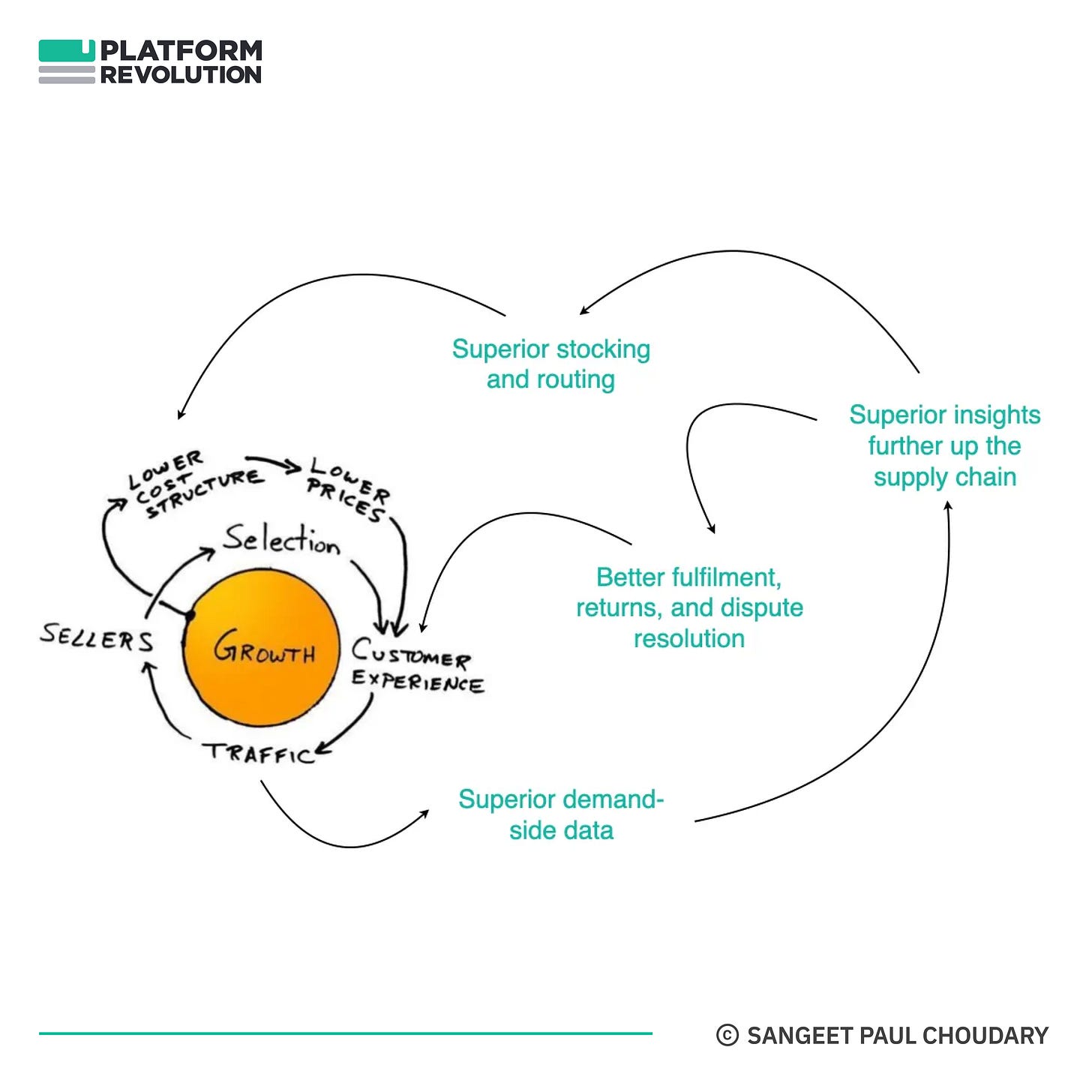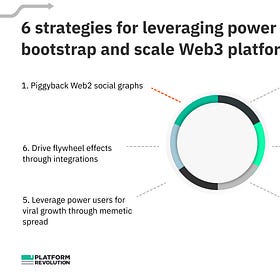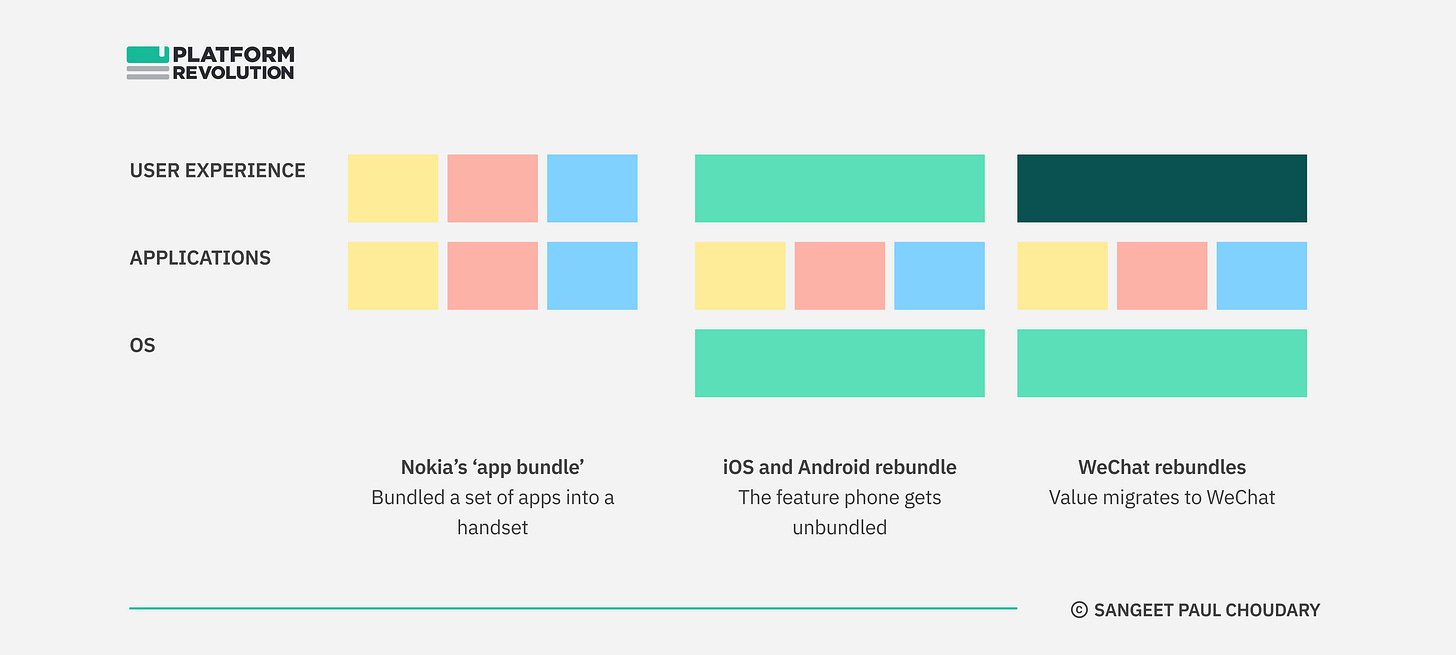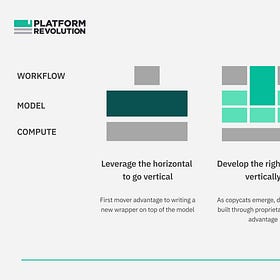The 2024 Tech Strategy Toolkit
Nine sources of tech-based competitive advantage
Every company is not necessarily a tech company.
But all strategy involves tech strategy.
You could be selling metals or farm produce, not technology. But technology plays an ever-increasing role in your ability to build and sustain competitive advantage.
Popular narrative emphasizes tech hype cycles - NFTs in 2021, Metaverse in 2022, and well, generative content creation in 2023.
But what’s far more important is how shifts in tech shape shifts in competitive advantage.
You may not need an NFT strategy in 2022. Or a metaverse strategy in 2023.
But you will always need to understand how to develop competitive advantage for your business and how tech shifts provide new tools in your strategic toolkit.
This post is about such tools that have become increasingly important over the past few years.
Drawing on work I’ve published particularly this past year, but also in 2021 and 2022, this post lays out nine different forms of tech-driven advantage.
The interface advantage
The cross-subsidization advantage
The brand integration advantage
The vertical integration advantage
The unbundling advantage
The composability advantage
The interoperability advantage
The community advantage
And most important…
The rebundling advantage
Let’s dig into this one!
1. The interface advantage
In an attention economy, control of the user interface is one of the strongest sources of competitive advantage!
It is also one of the most deeply contested value bottlenecks in any ecosystem, allowing you greater negotiation advantage over all other players.
a. Attention economics
As I’ve noted before in my post How to regulate Facebook and Google:
Business models are built around scarce and tradable resources.
Tradability affords value transfer and scarcity affords negotiation leverage in such transfer.
Attention is both scarce and tradable.
Attention is scarce - yes, because the sum total of human attention is a finite number.
But more important, with an abundance of content and interactions, our decision-making ability gets depleted, allowing our attention to be more manipulable as a resource.
Attention is also tradable. Sophisticated auction mechanisms trade our attention (and the attendant decision - which is already manipulable) to the highest bidder.
Your goal as the interface of choice is to manage both the scarcity and tradability of attention.
b. Interface advantage = Primacy of relationship + control point
But how do you build an interface advantage?
As I explain in Why your super-app will most likely fail:
You gain the right to manage attention scarcity by gaining primacy of the user relationship through a core use case on which you have primacy of user relationship.
You gain the right to manage attention tradability by ensuring you own a key control point through which user attention may be traded with third parties.
How do you gain primacy of the user relationship?
Here, we need to make a distinction between primary demand and secondary demand.
A homebuyer has primary demand for a house. This primary demand generates secondary demand for mortgage.
In healthcare, the primary demand for cure and wellness creates secondary demand for pills and procedures.
The secondary demand is a means to an end, the primary demand is the end.
In an industrial economy, serving secondary demand was hugely profitable as long as you owned proprietary channels (e.g. bank branches, clinics etc.) and some form of regulatory moat (e.g. license to operate).
In an attention economy, where consumers are constantly connected and attention is both scarce and tradable, owning the primary demand is key.
The firms that own primary demand will eventually commoditize the ones that own secondary demand.
This is why banks want to move ‘beyond banking’ because they see profit pools shifting into the primary demand that ‘wraps around’ their product lines.
To build an interface advantage, you need primacy of user relationship and that is best owned by owning a core use case in the primary demand.
Here’s the full deep-dive, with a particular focus on the one business model that rules them all at the interface - the super-app model:
Why your super-app strategy will (most likely) fail
Everyone wants to build a super-app. Yet, almost every super-app will fail. You don’t get to be a super-app just because you have a lot of users on your core app and you now decide to bundle multiple services into the same interface. You gain the right to be a super-app by
2. The cross-subsidization advantage
How do the BigTechs crowd startups out of entire layers in the value chain?
They leverage a fourth tool in the toolkit: cross-subsidization.
Cross-subsidization allows you to build one deep profit pool and commoditize multiple complementary value chain layers by deeply subsidizing capabilities at those layers and starving the layer-specific players for profits.
If you’re an incumbent, this is by far the strongest tool in your toolkit.
a. Commoditize the complement
How to lose at Gen AI (the most read post of the year) explains how cross-subsidization helped incumbents beat startups for the IoT prize.
Most incumbents - companies like Schneider, Johnson, and Honeywell - subsidized IoT services and bundled in the connected services with their existing profit pools where they charged for devices.
Clueless startups looking to capture value on connected services tried to subsidize their hardware and were left footing a huge manufacturing bill for subsidizing low quality hardware that took them nowhere.
Incumbents, instead, 'commoditized the complement' and increased the value of their devices by bundling in subsidized connected services - a huge business model advantage.
Effectively, startups footed the experimentation and customer discovery bill while incumbents captured all the value.
b. Cross-subsidization in Gen AI
Something similar is now playing out in Gen AI as well.
Incumbents can subsidize AI by bundling it with an existing already-working profit pool. Startups, instead, need to charge for AI. Workflow-only startups that gain traction but don’t own a proprietary model may get stuck with a huge LLM API bill, making AI subsidization untenable even with heavy VC funding.
Startups focusing on innovation (largely prompt engineering and UX) at the workflow layer are merely footing the bill for finding product-market fit, while a well-positioned incumbent on the prowl can swoop in once early signs of product-market fit are visible.
c. The BigTech get Bigger
And the BigTechs - who redrafted the cross-subsidization playbook for digital value chains - are poised to win in an especially big way:
At the compute layer, Microsoft, Amazon, and Google benefit from undeniable scale advantages with their cloud computing capabilities.
At the workflow layer, Google’s search dominance and Microsoft’s Office suite are examples of large installed bases that become more sticky when AI-aid is bundled into the workflow.
Finally, all these players are leading investors at the model layer. Google with its in-house efforts and Microsoft with its investment in OpenAI.
By vertically integrating across all three, these players get significant advantages both in terms of economics (lowering the costs of inference) and negotiating power (by squeezing out profits from players sandwiched in between their dominant layers).
Here’s the full deep-dive on cross-subsidization:
How to lose at Generative AI!
Value capture in Generative AI is going to be a disappointment for most startups! Some 'platform shifts' favour the disruptors, some favour the incumbents. Generative AI looks overwhelmingly poised to favour incumbents. And, of course, why not - you’d say - incumbents have all the data advantage.
3. The integrated brand advantage
How do you turbo-charge brand advantages in digital value chains?
By building integrated brand experiences, powered by an ecosystem of connected services.
As we note in the interface advantage above, owning the primary demand is a key tool in your digital competition arsenal. Integrated brand experiences uniquely position you for winning in the primary demand.
In Consumer brands in the platform economy, I explain how primary demand ownership gives leverage over secondary demand players.
Consider the problems solved by brands like Nike and Sephora.
For Sephora, the primary demand for grooming and beauty drives the secondary demand for cosmetics.
For Nike, shoes constitute secondary demand, health and fitness are the primary demand.
By serving the primary demand of the customer, integrated brands command right of customer relationship and can intermediate the customer’s relationship with third parties which serve this secondary demand.
a. Sephora - the integrated brand advantage
Consider Sephora, for example, whose integrated brand experience integrates its in-store experience with its digital services and social networks, linked together through the user’s digitized profile.
Sephora has invested heavily in facial feature recognition AI to track facial features and build augmented reality experiences using this capability. Its integrated brand experience includes virtual try-ons to enhance its digital commerce experience. Sephora has developed services to help consumers sample different scents and fragrances.
It also engages its user community through social networks like Beauty TIP (teach, inspire, play), an integrated experience workshop, where customers learn via group beauty classes, using Sephora’s Virtual Artist technology, Beauty Board, and its gallery of products.
b. Nike - the integrated brand advantage
Nike orchestrates a similar integrated brand experience, combining a powerful brand with deep community engagement:
c. Walgreens - the integrated brand advantage
And Walgreens similarly orchestrates an integrated experience strung together around its loyalty program:
For a deep-dive on all three case studies, have a look at the analysis below:
How consumer brands like Nike, Sephora, and Walgreens compete in ecosystems
In an earlier edition of the newsletter, I introduced a new framework to explain the difference between different ecosystem positions. Over the course of the next few editions of the newsletter, we dive deeper into each of these business models. Let’s start by looking at aggregator business models and the specific strategy of playing in the primary dema…
4. The vertical integration advantage
Digital business models are notorious for running counter to vertical integration. Digital technologies reduce transactions costs and unbundle vertically integrated models.
Yet, while physical value chains get unbundled, a new form of advantage emerges in vertical integration:
Vertical integration across the data value chain!
This is best explained by looking at the role that demand-side data integration plays in supply network design and optimization.
a. The real Amazon flywheel
Consider Amazon’s flywheel as explained in my most recent article - Why offline retailers fail at online marketplaces.
Demand-side data informs the entire supply chain.
Why is demand-side data integration so important to a successful supply chain play?
To understand this, let’s look at another online commerce player that defeated an offline incumbent through the sheer brilliance of its supply chain: Netflix.
If 2012 feels like ancient history, it’s worth calling out at this point that long before Netflix became the online streaming giant that it is today, it was a DVD rental startup delivering DVDs to doorsteps across the US. Blockbuster - the appropriately named incumbent - was the 800 pound gorilla that no one could unseat.
And yet Netflix did, in record quick time.
b. The Netflix trade-off - or lack of it
As I explain in Amazon is a logistics beast:
You could argue that there were many things that drove Netflix’s success in the DVD rental business. But the one thing that Blockbuster could never compete with was the integration of demand-side queuing data (users would add movies that they wanted to watch next into a queue) with a national-scale logistics system. All this queueing data aggregated at a national scale informed Netflix on upcoming demand for DVDs across the country.
Blockbuster could only serve users based on DVD inventory available at a local store. This resulted in:
1) low availability of some titles ( local demand > local supply), and
2) low utilization of other titles (local supply > local demand).
Netflix, on the other hand, could move DVDs to different parts of the US based on where users were queueing those titles. This resulted in higher availability while also having fewer titles idle at any point.
Queueing data improved stocking and resulted in higher utilization and higher availability. It allowed Netflix to serve local demand using national-scale inventory.
Notice the red arrows that I’ve thrown in there? Those are the two arrows that make all the difference.
One arrow ensures high availability of DVDs locally, the other arrow ensures high utilization of DVDs at national scale.
There was no way for Blockbuster to compete with Netflix within the framework of local inventory - local fulfilment. Netflix fundamentally changed that framework.
Traditional supply chains need to manage the trade-off between utilization and availability.
But the ability to predict demand solves this trade-off and informs stocking and logistics.
For more on this advantage, have a look at the deep-dive below:
Why offline retailers fail at online marketplaces
Once upon a time, retailers invested in large swathes of land, arranged aisles with the choicest of products, and built a fortune serving suburbia. Then Amazon happened! Over the past two decades, as Amazon has increasingly eaten retail with transaction economics that don’t make sense, retailers have constantly looked for ways to beat Amazon at its game.
5. The unbundling advantage
How do you unseat an established incumbent, even more so a platform with well-established network effects?
The answer lies in protocol-based unbundling.
a. Protocols and unbundling
As I explain in Unbundling the unbundlers:
Marketplaces bundled demand-side onboarding, decision support systems, and tools with supply-side onboarding, decision support systems, and tools. Protocols unbundle the two.
For instance, a marketplace like Ebay bundles seller onboarding, seller analytics, buyer onboarding, buyer decision support, search functionalities, and exchange infrastructure. All these components will be unbundled.
As a result, we move away from central market-maker architectures to decentralised agent-based architectures, all coordinated by a shared, common protocol.
Protocols are an effective way to attack established platforms. Yet, protocols win only under certain conditions.
b. The three laws of protocol-based unbundling
In The ONDC Conundrum, I lay these conditions out in the form of the three laws of protocol-based unbundling.
First:
A protocol creates value through unbundling to the extent that it can absorb and resolve the coordination costs originating from unbundling.
Unbundling can create a nightmare if the coordination costs aren’t sufficiently resolved.
Second:
The more the number of steps in the value chain you unbundle, the higher the coordination costs.
Third:
A protocol’s ability to absorb coordination costs is inversely proportional to the degree of variability in use cases it needs to directly coordinate.
Bringing all this together, we realize that protocol effectiveness may lie across a spectrum - from weak to strong.
The lower the variability in use cases and the lower the coordination costs, the stronger the protocol’s effectiveness at mediation.
The higher the variability in use cases and the higher the coordination costs, the weaker the protocol’s effectiveness at mediation.
If you’d like to read through a detailed analysis applying the above considerations, have a look at:
The ONDC conundrum: Where protocols win... and where they don't...
India’s ONDC (Open Network for Digital Commerce) has been the most ambitious decentralized alternative to the centralized e-commerce marketplace model pioneered by Amazon and others. Yet, it has (thus far) struggled to fully deliver on its promise to reorganise the commerce ecosystem through a protocol-based approach.
6. The composability advantage
a. Unbundling increases modularity.
Digitization across the value chain drives unbundling of the value chain as I explain in an earlier analysis of the value stack:
As transaction costs fall with the adoption of enterprise Saas, the vertically integrated value chain starts to unbundle.
This unbundling of the vertically integrated industry architecture is creating a more modular, layered ecosystem where firms at every layer specialize in one specific value-creating activity.
So what’s the big deal about modularity? Well…
b. Modularity begets composability.
In The Building Blocks Thesis, I explain how modularity converts the value chain into a set of building blocks which can be ‘composed’ into new solutions.
Digital building blocks are standardized and modular units of value creation which, when combined, drive exponential value creation in an ecosystem.
Solutions are often consumed as bundles of value. For instance, a primary school student consumes education as a bundle comprising textbooks, teacher-delivered training, self-administered testing etc.
A building blocks approach unbundles a solution bundle into its fundamental constituents - in the above example, textbooks, teacher-delivered training, self-administered testing etc. would serve as individual building blocks. Building blocks may be combined and recombined to create a wide scope of end solutions, each solution leveraging common building blocks.
Unbundling increases modularity. Modularity begets composability.
c. Developer commitment as competitive advantage
With increasing composability, developer engagement and commitment emerges as a key source of competitive advantage.
As I explain in Winning in open and decentralized ecosystems:
Developer engagement is the primary source of value in modular ecosystems.
On the developers' part, this requires commitment of developer time, resources, capabilities etc.
But developer commitment is also scarce, and hence, a source of competitive advantage:
Developer engagement and resource commitment involves high multihoming costs(costs to developers in simultaneously building for multiple platforms).
By building and committing resources to a particular ecosystem, developers are implicitly opting out of committing their limited time and resources to other (competing and non-competing) ecosystems.
Built on developer commitment, we’re seeing the rise of an entirely new source of advantage - the composability advantage. As I explain in DX is the new UX:
Developer commitment will emerge as a new value lever.
Unbundled firms will need developers to integrate with other firms around themselves.
As APIs proliferate, new innovation will require mashing up APIs rather than building ground-up, again, requiring developers.
And, finally, value in protocol-based ecosystems will largely be created by external developers.
Have a look at the deep-dive here:
DX is the new UX
UX (User Experience) has emerged as a key source of competitive advantage over the past two decades. But three key shifts - unbundling of the value chain, - growth in API-based business development, and - the rise of protocols are creating a new competitive frontier.
7. The interoperability advantage
Unbundling leads to modularity. Eventually, value is created in a modular ecosystem through interoperability.
Interoperability is rarely seen as a combative move, unless combined with a control point.
However, a specific form of interoperability - adversarial interoperability - can serve as yet another wrench in your tech strategy toolkit.
Adversarial interoperability is particularly advantageous in wresting advantage away from an incumbent.
A snippet from How to think about data regulation:
Using adversarial interoperability, a B-player wrests advantage away from the A-player by consistently ensuring interoperability with the A-player while also building its own standard.
Apple's success with Pages, Numbers, and Keynote, despite Microsoft's multi-decade dominance is a great example.
Airbnb interoperating with Craigslist was a similar adversarial move.
As platforms become more dominant, adversarial interoperability is an alternative to the break-up-big-tech-by-regulation model. Providing users the tools to break up monopolistic control of a platform can prove very effective.
Adversarial interoperability can be an effective weapon to unseat incumbents. For more on unseating incumbents, have a look at the full post:
How to think about data regulation
To understand value creation and regulation in the digital economy, we need to start with understanding the economics of data. Treating data as a physical asset and regulating data access and residency only scratches the surface. To regulate data well, we need to understand how data accumulation leads to control.
8. The community advantage
Community plays an important role in driving user retention. Within communities, power users play an especially important role.
Why do power users matter?
In Leveraging power users, I explain:
Power users play a key role in the creation of network effects. Not all nodes on a network are equal, some - power users - contribute much higher activity to the network than others.
Power users may be power producers or power consumers or both. Power producers bring higher supply to the platform. Power consumers are responsible for driving demand. Power users drive outsized activity on the platform. Early on, getting power users onto the platform helps overcome the chicken and egg problem that most platforms face.
With the rise of tokenisation and Web3, we now potentially have a more powerful way to leverage power users:
Through additional ownership benefits - both in terms of platform ownership and content ownership - power users are incentivised to keep promoting not just their own content (as they already did in Web2) but also the underlying platform and any derivative content that is created on the platform.
a. Tokenized community participation
In fact, tokenized community participation needs an entirely new playbook.
Have a look at the six strategies in detail at:
Web3 Network Effects: Leveraging Power Users
Web2 platforms like Kickstarter, Udemy, and Skillshare scaled by getting power producers onto the platform early on. These producers, in turn, onboarded their followers as consumers, some of whom, then further converted into producers and a cycle of user acquisition and ever-increasing network effects started building up.
9. The rebundling advantage
By far, the most powerful source of advantage in digital value chains and ecosystems accrues from rebundling.
a. Rebundling is key to establishing a dominant position in digital value chains:
Most 'disruption' of the status quo happens through unbundling. But most venture returns are realized through rebundling.
Fintechs specializing in one activity unbundle banks, Healthtech firms specializing in one aspect unbundle healthcare providers, and specialized energy startups unbundle utilities.
Yet, there is no sustainable value capture in unbundling. Unbundling unseats incumbents but doesn't create scalable and defensible value pools.
That is achieved through rebundling. Rebundling involves bundling multiple unbundled capabilities into a cohesive customer-centric offering.Most important, the successful ‘rebundlers’ establish a hub position and gain primacy of user relationship.
Venture capital chases unbundling because unbundlers hold the promise of rebundling and capturing value. Yet, most venture money is lost because a tiny handful rebundle.
Square, Plaid, Stripe are a few of the unbundling fintechs that successfully rebundled and dominated one or more horizontal layers in the value chain. Most others fell by the wayside.
b. Rebundling enables value to migrate to another part of the value chain.
WeChat started as an individual app with vertical advantage in gaming and communication. However, it moved on to use its dominance in communication to establish primacy of user relationship as the default communication channel. It then integrated communication with payments to control the two most important horizontal capabilities that allowed it to establish a new layer on top of the underlying OS.
c. So how exactly do you gain the right to rebundle?
There’s a secret to rebundling. It’s widely visible and yet largely hidden.
Everyone wants to rebundle. Everyone wants to be the hub.
Yet few actually manage to.
You can’t seat yourself at the centre of an ecosystem just because you want to.
Here’s the key to successful rebundling:
You need to own the key control point that delivers primacy of user relationship
Why was WeChat so successful at rebundling. It owned the two key control points - communications and payments - that enabled it to mediate all social and economic interactions between the user and third party apps.
The most-liked post of the year - How to win at Generative AI - explores ideas around rebundling and specifically applies them to creating competitive advantage with Gen AI.
How to win at Generative AI
A couple of weeks back, I wrote a post on How to lose at Generative AI. Which raises the counter-question, how do you win at Generative AI? Of the many GenAI copycats emerging, which are the few that win? This post is about winning at Generative AI.
Enjoyed reading this?
Here’s more on Me and My work.
And if you’d like to write in, just hit reply.



















What a fabulous summary to freshen anyone's thinking for the turbulent year ahead. Thank you!
Epic post, thanks for all the references to the previous body of work that you've shared 🙌